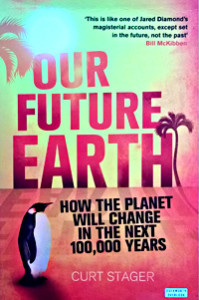Our Future Earth (also published as Deep Future)
How the planet will change in the next 100,000 years
by Curt Stager. Published by Duckworth Overlook www.ducknet.co.uk
The first thing I thought when I saw this book with it’s garish orange cover with penguin & palm tree motif so reminiscent of ’70’s eco-doom genre was ‘they can’t get the weather for next Tuesday right never mind predict 100,000 years of climate change!’.
However, I’m a sucker for deep futures so I picked it up anyway. In fact, the book was previously (2011) published under the title ‘Deep Future’ with a much more sober cover. Obviously the publishers thought a more alarmist cover would shift more units. A slightly misleading decision as Stager is anything but alarmist in his prose. He is a paleoecologist – one of those people who can tell you that hippos waded through the Thames in 50,000BC or whether Southern France was swamp or tundra in 120,000BC from pollen grains in sediment samples and ice cores.
Here he uses his knowledge of the deep past’s climate to assess the effects that rising temperatures will have on the global scale in the future. This is not ‘rising seas will swamp us all by 2100’ fearmongering but rather a reflection on the longer term changes to come. Even if we stopped carbon dioxide increases right now, the world will continue to warm for thousands of years and take tens of thousands to slowly cool back to today’s norms. The question he raises is how long we want that temperature spike to last – tens of thousand’s of years in a moderate carbon emission scenario or hundreds of thousands of years in a strong emission scenario.
He readily admits that our current climate models (of which there are many) simply are not up to the job of providing anything like reliable local (i.e. country or region) prediction. The only thing they agree on is the broad global overview – poles will get warmer, the equator will get drier, mid-latitudes will get wetter and the oceans will get more acidic. Possibly.
These broad changes are enough to outline some drastic alterations to the lifestyles and welfare of tens of millions of people and many, many endangered species. It’s not all bad though. While there will doubtless be many losers in the warming world – we may have to say goodbye to polar bears and the poor of many low-lying countries will suffer most as the poor always have – there will be winners too. Earth has been this warm or warmer in the deep past. Melting ice fields will open up new trade routes and fisheries, as well as new territories for warmth-loving animals. Many species will move North or to higher ground in the face of rising temperatures – local extinction does not necessarily mean global extinction. People will adapt too over generational timescales and may suffer more in the global cooling trend to come.
We may actually be doing the world a favor by pumping out CO2. Without us, a new ice age would shortly scour all of Northern and min-latitude Europe, North America and Russia causing vastly more extinctions and environmental damage than global warming will. Uniquely, Stager suggests we leave our coal in the ground, not only to stem excessive CO2, but so that our far future descendants can use it to stave off future ice ages!
Stager’s book doesn’t try to scare you or lull you into a false compliancy. It’s a sensible and well-balanced look at the losses and possible gains a warmer world might bring and can thus be heartily recommended as a book that will probably annoy both green campaigners and climate skeptics equally.
